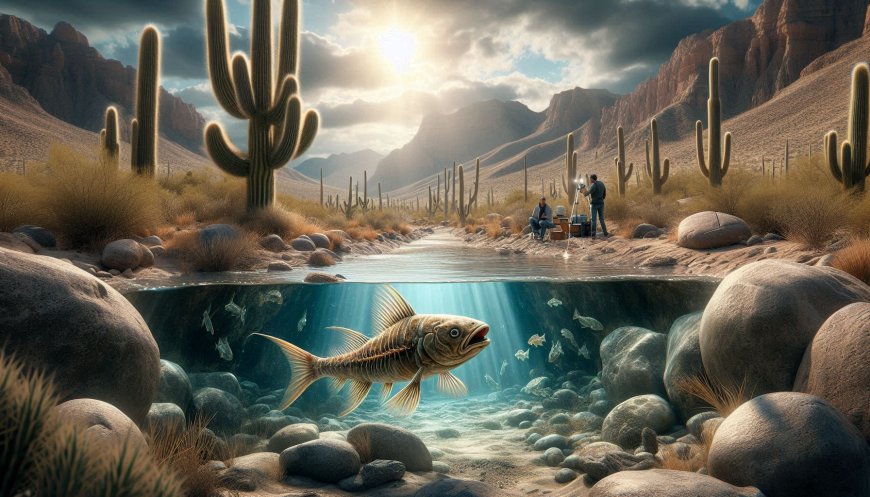Arizona Desert Fish Discovery Rewrites the History of Longevity in Vertebrates
Groundbreaking discovery of a desert fish in Arizona reshapes the understanding of vertebrate longevity, revealing evolutionary mysteries in the arid landscape

In an unexpected twist, the desert-dwelling buffalofish of Arizona has thrown the scientific community into a frenzy, forcing researchers to rethink the possibilities of vertebrate longevity. A groundbreaking study by scientists at the University of Minnesota has uncovered that these unassuming freshwater fish can live for over a century—an astonishing discovery that reshapes our understanding of aging in animals.
The Hidden Longevity of Arizona’s Buffalofishes
Buffalofish, specifically the bigmouth buffalo, smallmouth buffalo, and black buffalo, native to Minnesota and now thriving in the Arizona desert, are the stars of this scientific breakthrough. For years, these fish were misidentified and overlooked, often grouped with invasive carp species. As a result, they were left unprotected by fishing regulations. But recent research has shed light on their true potential, positioning these fish as extraordinary models for studying longevity.
The research team, led by Dr. Alec Lackmann of the University of Minnesota Duluth, discovered that some of these buffalofish species have lifespans that exceed 100 years—a feat unheard of for freshwater fish. Using a novel approach to age determination, Dr. Lackmann and his team examined otoliths, or "earstones," which are small structures in the fishes' heads that develop layers over time, much like the rings on a tree. By counting these layers, the team could accurately determine the age of the fish, unlocking their secrets of longevity.
Stunning Findings from the Arizona Desert
The results of the study were nothing short of remarkable. Among the key findings:
- Three species of buffalofish were found to have lifespans exceeding 100 years, making them some of the longest-living vertebrates known to science.
- A population of these fish in Apache Lake, Arizona, was made up primarily of individuals over 85 years old.
- Some of the buffalofish in Apache Lake may have originated from a 1918 stocking into nearby Roosevelt Lake, meaning they have survived for more than a century in the wild.
This discovery not only highlights the resilience of these fish but also reveals the untapped potential of buffalofish in aging research. For decades, these fish lived undisturbed in Arizona’s lakes, quietly defying the norms of vertebrate lifespan.
A New Frontier in Aging Research
The implications of this discovery stretch far beyond the waters of Arizona. Buffalofish are now seen as a key to unlocking the mysteries of aging. With their remarkable lifespans, these fish present a unique opportunity for scientists to study aging-related processes, disease resistance, and the biological mechanisms that allow them to thrive for more than 100 years.
Dr. Lackmann envisions a future where the DNA and physiological traits of buffalofish are studied to understand how they maintain health and vitality for so long. Apache Lake, where many of these centenarian fish reside, could become a scientific hub for research into aging, not just in fish, but potentially offering insights applicable to other species, including humans.
The Role of Conservation and Collaboration
One of the most exciting aspects of this discovery is the collaborative effort between scientists and conservation-minded anglers. Observant anglers first noticed the unusual markings on these buffalofish and reached out to Dr. Lackmann’s team, leading to a fruitful partnership that enabled this research. Their collaboration underscores the importance of engaging the public in scientific discovery, especially when it comes to the preservation of species with extraordinary biological traits.
A Bright Future for Buffalofish and Aging Studies
While the commercial fishing of buffalofish populations in other lakes has impacted their longevity, Apache Lake’s population has thrived, offering a glimpse into the potential for long-term ecological research. As buffalofish take their place in the spotlight, their role in gerontological research is just beginning to unfold.
In conclusion, the discovery of these centenarian fish not only rewrites what we thought we knew about vertebrate aging but also paves the way for new frontiers in the study of longevity. With each century-old buffalofish swimming in Arizona’s lakes, we come closer to understanding the secrets of long life, resilience, and survival in ways that could impact science and medicine for generations to come.
What's Your Reaction?






































































































